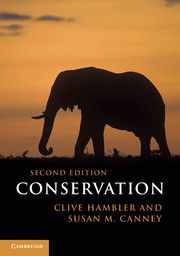Book contents
- Frontmatter
- Contents
- Preface to the Second Edition
- 1 Introduction to conservation
- 2 Threats to biodiversity
- 3 Evaluation of priorities for species and habitats
- 4 Monitoring and Environmental Impact Assessment
- 5 Management of natural and fragmented habitats
- 6 Management of species
- 7 Sustainable use, semi-natural cultural landscapes and the matrix
- 8 Restoration and offsetting
- 9 Environmental policy
- References
- Index to species names
- Index
- Plate section
4 - Monitoring and Environmental Impact Assessment
Published online by Cambridge University Press: 05 February 2013
- Frontmatter
- Contents
- Preface to the Second Edition
- 1 Introduction to conservation
- 2 Threats to biodiversity
- 3 Evaluation of priorities for species and habitats
- 4 Monitoring and Environmental Impact Assessment
- 5 Management of natural and fragmented habitats
- 6 Management of species
- 7 Sustainable use, semi-natural cultural landscapes and the matrix
- 8 Restoration and offsetting
- 9 Environmental policy
- References
- Index to species names
- Index
- Plate section
Summary
The subject of this chapter is one of the most important to successful conservation. It is essential to those doing field surveys when evaluating sites for conservation at a range of scales, and for assessing both quantity and quality of biodiversity. This chapter also examines the selection and use of indicator groups to give rapid assessment of sites, at smaller scales than in Chapter 3. These methods are used for several reasons: for baseline survey when choosing sites; for monitoring changes; for Environmental Impact Assessment (EIA) before developments; and for assessment of management methods. An evaluation before and after management will help detect and interpret changes due to that management, providing evidence for its impacts and effectiveness. It becomes of particular importance with the growing debate over biodiversity offsetting and banking (Chapter 8), as these aim to reduce the impacts of developments by trading sites, and require an accurate and unbiased assessment of site value (Section 8.6).
Even if one is never going to undertake an ecological survey oneself, understanding the basic principles and methods of ecological survey is useful to be able to interpret results. Determining conservation policy and management will require understanding these results in conjunction with social science, as demonstrated in the case study in Chapter 9. This will also require unbiased methods for collecting data on public opinion, local activities and local knowledge (White et al., 2005; Lawrence, 2010; Newing et al., 2010).
- Type
- Chapter
- Information
- Conservation , pp. 125 - 160Publisher: Cambridge University PressPrint publication year: 2013



